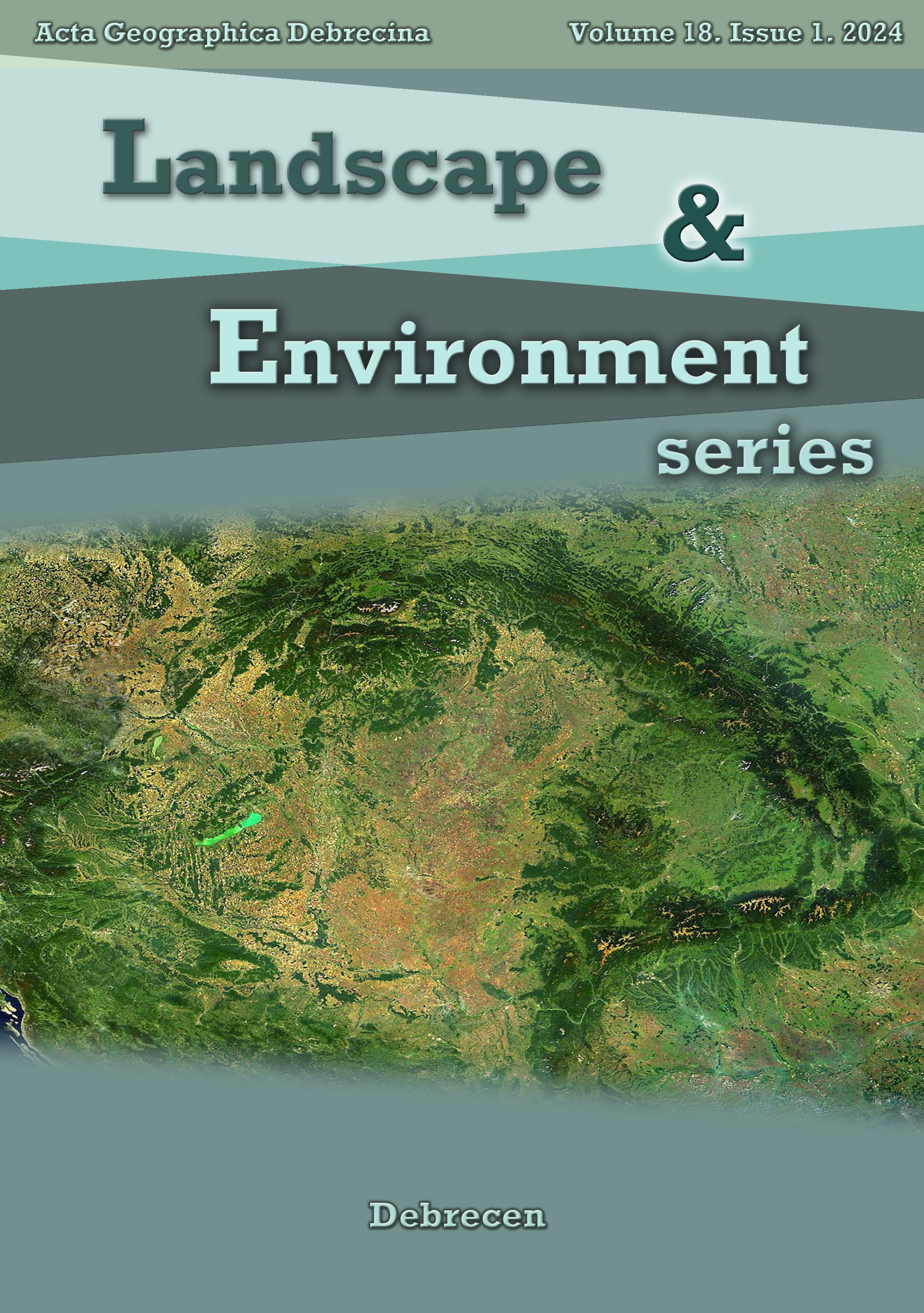Vol. 18 No. 1 (2024)
Pooja Ramanuj – Shankar Laware – Nitin Karmalkar. Assessment of spatio-temporal waterline changes of a reservoir: A case study of Ujjani wetland, Maharashtra, India
Pranamee Gogoi. A GIS-based study on the changing course of the river Jiadhal in the Dhemaji district, India
Tamás Mihály Veres. Developing a strategy of data collection and pre-processing to assess bike sharing system station placements with the help of GIS
Neha Chauhan – Anjali Naik – Mahavir Singh Negi. Rainfall dependency and water quality assessment of springs of three villages of Rudraprayag district: an analysis of veins of Uttarakhand Himalaya
##issue.tableOfContents##
Articles
-
Assessment of spatio-temporal waterline changes of a reservoir: A case study of Ujjani wetland, Maharashtra, India
1-13Views:257The Ujjani reservoir is an artificial inland wetland and a potential Ramsar site in Maharashtra, India. The present study investigates the changes in the surface water area over time using remote sensing imageries (LANDSAT, LISS-III, Sentinel 2 series) for four decades (1981 to 2021) and the normalized difference water index (NDWI). The study reveals that the overall mean amount and rate of decrease in the surface water area are estimated at 20.50% (44.31 + 30.38 km2) and 0.75% year-1 (1.62 + 1.36 km2year-1), respectively. Furthermore, multiple correlation matrix analysis shows a strong positive correlation between surface water area and rainfall while a weak negative correlation with mean annual temperature (TMAX). Thus, indicating rainfall as the principal factor in inducing changes to the surface water area of the Ujjani wetland. However, the study also finds that the impact of the dramatic rise in population growth and anthropogenic activities in the form of overexploitation and land encroachments for agriculture are gradual but significant cursors to wetland degradation. Hence, the study recommends periodic monitoring, management, and conservation of wetlands, by employing stringent policies and effective technological measures.
pdf315 -
A GIS-based study on the changing course of the River Jiadhal in the Dhemaji district, India
14-27Views:219River bank-erosion, deposition and channel-shifting are considered most dynamic and significant geomorphological processes formed by complex geological, hydrological, and anthropogenic factors. In the present study, river Jiadhal is one of the main sub-tributary of the River Brahmaputra in the Dhemaji district of Assam that changes its channel course frequently due to bank-erosion and sediment-deposition in the intermediate part and lower course of the channel. A study on the changing course of the river Jiadhal was carried out using satellite imageries for the years 1987, 1997, 2007 and 2017. The study found that the changes in the river vary from time to time and the bank-erosion and sediment-deposition fluctuate from place to place. The total area of bank-erosion is 13.34 km2 from 1987 to 2017 and the total area of sediment-deposition is 14.59 km2 from 1987 to 2017. This paper evaluates how the shape, size and position of the Jiadhal River have changed from the years 1987 to 2017 using remote sensing and GIS techniques. The study is also necessary for effective management along the side of the river Jiadhal to control bank erosion and to mitigate the adverse impact of erosion and channel-shifting.
pdf363 -
Developing a strategy of data collection and pre-processing to assess bike-sharing system station placements with the help of GIS
28-35Views:131Our research presents a methodological framework for analyzing bicycle-sharing systems, using the self-service bike operations of JCDecaux in Toulouse as a case study. The objective was to identify a method for obtaining a cleansed and structured attribute list that could be useful in evaluating and optimizing the placement of bicycle rental docks. Utilizing open data, our approach involves developing a Python script within QGIS to create new layers around each of the 288 studied bicycle rental stations, based on a selected 100-meter buffer. This buffer size is chosen to reduce data overlap in dense urban settings. The script is designed to collect urban features within these buffers that register as multipolygons (mainly buildings) or points (amenities, transportation features), moreover it applies categorization of data, such as identifying and marking the different building types. The method includes a basic visualization of potential data in QGIS using OpenStreetMap.
pdf159 -
Rainfall Dependency and Water quality Assessment of springs of three villages of Rudraprayag District: An analysis of veins of Uttarakhand Himalaya
36-47Views:223A spring is a crevice in the substrate that forms naturally and allows water to pour out directly from the earths subsurface. Every major river in the country has a system of springs that serve as a symbolic representation of its source. But this very fundamental source of many resources is in peril. The problem is mainly related with the reduced discharge rate of water from the spring. The reason of truncate discharge rate is variability in the rainfall pattern in the recharge area due to the climate change over the years.To ensure the quality and security of the public's water supply, regular quality assessments of drinking water sources are required. In consequence, this study not only analyse the rainfall dependency of springs but also evaluated the spring water quality for drinking, using water quality index, in three villages located in Jakholi block of Rudraparayag district, Uttarakhand. The ten foremost physiochemical elements that regulate water quality—Nitrate, Fluoride, Iron, pH, Turbidity, Chloride, Residual Chlorine, Magnesium, sulphate, and Hardness—were investigated to ensure compliance with guidelines defined by the Bureau of Indian Standards IS: 12500:2012. After examining the data, it became apparent that all of the indicators pointed to acceptable water quality, making it ideal for drinking. However, because of its low discharge and great reliance on rainfall, its position is getting more detrimental.
pdf265
